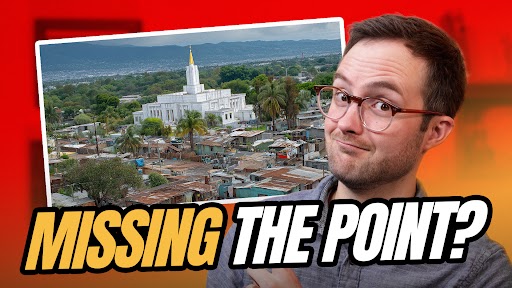To watch this video on YouTube, click HERE.
Video Transcript:
A lot of people view Latter-day Saint temples as those expensive buildings where Mormons do all of their secret culty rituals, but in this video I’m going to explain why LDS temples are actually helping to solve one of society’s biggest problems.
Quick story: A while back, I got pretty sick. I was still a functional human being—it was mainly just cold symptoms and a painful cough. But a few months passed, and it just wasn’t going away. I eventually went to Urgent Care and found out why: I had pneumonia. Cough drops and cold medicine were helpful in the moment, but I was treating symptoms, not the underlying and infinitely more serious sickness. Once I treated the pneumonia, the other symptoms finally improved.
Poverty. Drug abuse. Self-harm. Crime. These are all serious social issues, and we should be treating them in whatever ways we can. But what are the underlying sicknesses at play here? Can we change something now in order to avoid these problems later? What are the risk factors that increase the chances that a child will grow up and experience these issues?
The non-Latter-day Saint professor Nathan Schlueter wrote in Crisis Magazine that “The single greatest contributor to our social pathologies such as addiction, mental illness, suicide, and violent crime is the breakdown of marriage and the family.” Children who experience family disruption, such as divorce or single parenthood, are more likely to later commit violent crime, drop out of school, experience child abuse, self-harm, depression, drug abuse, jail time, teen pregnancy, lower GPAs, health problems, poverty, and homelessness.
Now, I’m not bringing this up to shame anyone who has experienced a family disruption. Sometimes divorce is the best option on the table. Some disruptions, like the death of a parent, are outside of our control. These outcomes for children are, of course, not guaranteed. But the research is what it is, and family disruptions are a risk factor for a very long list of serious personal, familial, and societal issues.
If we want to help future generations avoid these issues, one of the main areas of focus needs to be on creating strong, healthy, and lasting family units.
Enter stage right: Latter-day Saint temples. There are a variety of ordinances or ceremonies performed in these temples, but there is one specific ordinance that James E. Faust referred to as “the capstone of the holy endowment.” I love the way Bruce R. McConkie put it in 1970: “Thus celestial marriage is the crowning ordinance of the gospel, the crowning ordinance of the house of the Lord. Thus, the family unit is the most important organization in time or in eternity.”
Not only do Latter-day Saints consider marriage to be eternal, but we also consider it to be essential if we want to reach our full potential after this life. Then-Elder Russell M. Nelson taught, “In God’s eternal plan, salvation is an individual matter; exaltation is a family matter.”
In 2003, Elder F. Burton Howard gave an analogy that I’ll never forget. Comparing his wife’s precious silverware to eternal marriage, he taught, “If you want something to last forever, you treat it differently. You shield it and protect it. You never abuse it. You don’t expose it to the elements. You don’t make it common or ordinary. If it ever becomes tarnished, you lovingly polish it until it gleams like new … Eternal marriage is just like that.”
Now, Latter-day Saints are regular people. Getting married in the temple doesn’t guarantee a successful marriage. Divorce is allowed. Some marriages are happier than others. Life happens. But generally speaking, the statistics do indeed reflect the doctrine. At least in the United States, Latter-day Saints are more likely to get married, stay married, and be happier in marriage.
A Pew Research survey asked Americans to rank how important certain life goals were to them. Only 34% of the general public considered having a successful marriage to be one of the most important things in life. Among Latter-day Saints, that percentage more than doubles, coming in at 73%. Only 50% of Americans felt that being a good parent was one of the most important things in life. For Latter-day Saints, that number jumped to 81%.
I’m of course not saying that Latter-day Saints are the only ones who care about marriage and parenthood. That’s certainly not true, but the data does indicate that Latter-day Saints tend to value marriage and parenthood more than the general public. And temples are a big reason for that.
Whether you agree with Latter-day Saint doctrine and theology or not, I suspect that this emphasis on families makes more of a difference than we’ll ever be able to measure. People complain that temples are too expensive and that the money would be better spent on social issues. But temples do address social issues; they’re just doing it at the root instead of the leaves. Of course, this isn’t a this or that situation, it’s a this and that situation. Yes, let’s absolutely feed the hungry and clothe the naked — and there are always things we can do to be better at that — but lasting societal healing isn’t going to happen until we battle the underlying issues.
If people think temples are a waste of time and money, they might be playing checkers while the Church is playing chess—sparing families from pain, potentially generationally, by setting families on a path that is designed to be less likely to result in family disruption.
Of course, there’s a lot more to say about temples than we’ve covered here. If you want to dig a little deeper and get a little more theological, go check out this interview we did with Brad Wilcox. It’s one of our most popular videos yet. I’ll see you there!

